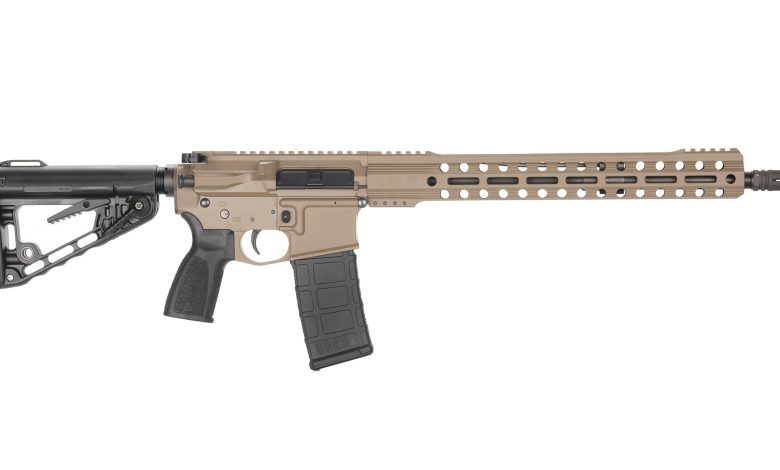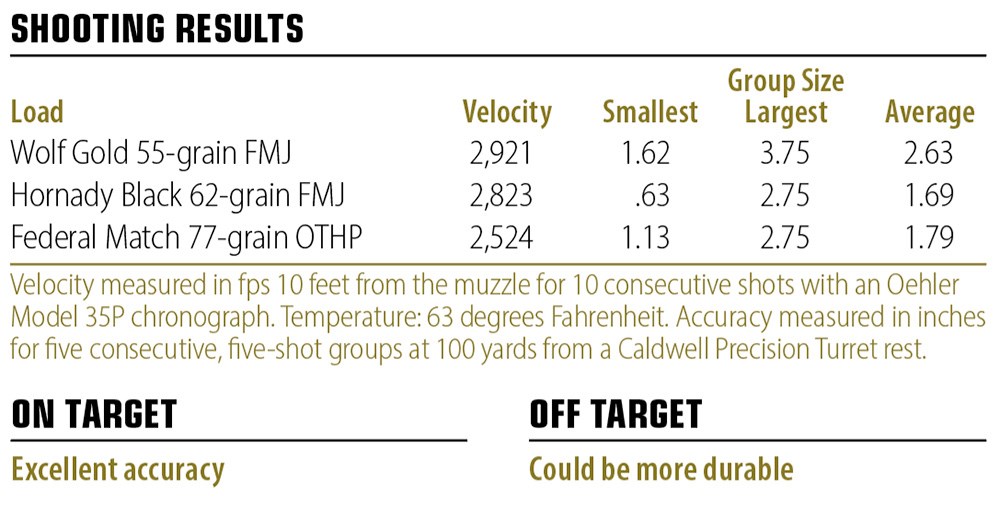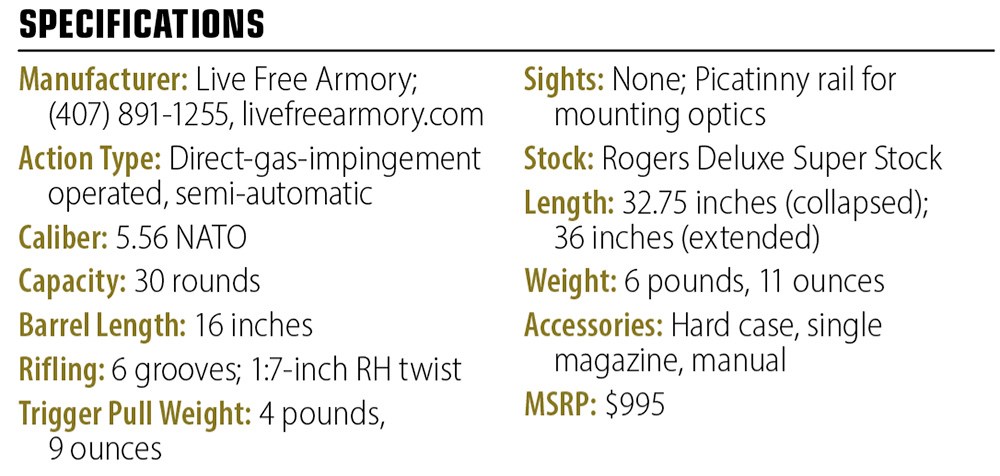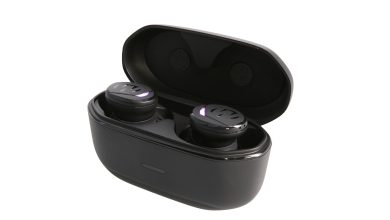Review: Live Free Armory LF556 LEO Tactical Carbine

Live Free Armory (LFA) isn’t a brand name every gun enthusiast may recognize, but the Melbourne, FL, company is hardly a newcomer to the firearm industry. It first started making AR-10 receivers in 2014, followed by Glock slides and eventually complete firearms, which now include six AR-15s in four chamberings, two striker-fired, polymer-frame pistols and two double-stack 1911-pattern pistols.
Though the company’s firearms don’t break new ground in their designs, it caught my attention at SHOT Show 2023 because of competitive pricing and a lifetime warranty which transfers with the firearm. Moreover, the LF556 LEO Tactical Carbine reviewed here is also guaranteed to deliver 1-MOA or smaller three-shot groups.
The LEO follows the mainline design of contemporary, tactical-style AR-15s. It is chambered in 5.56 NATO, uses the direct-impingement-gas-operating system and features a 16-inch, government-profile barrel with an A2-style flash hider, a telescoping stock and a 15-inch, narrow-profile aluminum handguard. A forward assist is included for those rare, but meaningful occasions where the bolt hangs up out of battery and needs to be closed to enable the carbine to fire. The LEO weighs 6.7 pounds unloaded and is 32.75 to 36 inches long depending on stock setting. Upon this foundation as a nimble rifle well-suited for home defense, several upgrades enhance its function, namely, an ambidextrous charging handle, Rogers Super Stock and an improved trigger and handguard.
The LEO’s receivers start life as 6160-T6 aluminum billet milled and are finished in-house with H Series Cerakote. My test rifle’s finish was well executed, with even application. Though LFA matches receivers that fit tightly together early in the manufacturing process, those on my sample had minor—but noticeable—front-to-rear movement from slightly oversize takedown-pin holes that may be correctable using an Accu-Set Expanding Pin from Barnes Precision. Side-to-side movement of the upper and lower receivers, however, was very slight and not in need of tightening except to satisfy the most OCD of us.
A standard A2 “birdcage” flash hider at the muzzle is flanked by a QD sling swivel mount and a Picatinny rail for a front sight • Thril’s Rugged Tactical grip offers excellent purchase • Noticeable in the LF556’s profile is the mostly bare handguard • An ambidextrous charging handle and a forward assist round out controls • The two-stage match trigger made accuracy work simple and was lighter than expected • The Rogers Deluxe Super Stock has plentiful sling-attachment points and essentially eliminates all wobble.
LFA had used Ballistic Advantage barrels previously, but started making its own in 2024. The barrel on the LEO is button-rifled with a 1:7-inch twist, is made from 4150 CMV steel and is QCQ finished. The M16-style bolt carrier and bolt are made from 9310 steel, and each bolt is MPI tested to weed out invisible cracks that could compromise the strength of this critical part. The LEO uses a mid-length gas system and the low-profile gas block is attached to the barrel with Allen screws rather than pins, which makes barrel changing simpler.
The handguard and buffer tube are made from 6061-T6 aluminum. The buffer-tube castle nut isn’t staked, which makes life easier for those who wish to switch to an ambidextrous safety that requires the castle nut to be loosened to access the safety detent pin. The nut does have staking notches, however, if you’re talented enough to stake it using a punch and hammer without slipping and marring the receiver. If you’re not that adroit, the staking tool from Tango Uniform makes castle-nut staking consistent and riskless. The charging handle’s levers extend nearly 1 inch outward from the receiver, offering a good balance between rapid accessibility and snagging onto your gear when the rifle is slung against your chest.
Noticeably smoother than a typical AR trigger, the LFA’s had just heavier than a 4.5-pound pull weight, which was about a pound lighter than I expected. As for the handguard, LFA resisted the temptation to mill superfluous rail slots along the entire top section which could abrade your support hand should you use a “C”-clamp-style grip. Instead, the company includes a short rail section at the front and rear which can be used for mounting sights or lights. There’s also full-length M-Lok slots on the other three sides and four holes to attach QD sling swivels.
Finally, the Rogers Super Stock is a superb choice for a tactical rifle. It’s strong and lightweight with a QD-sling socket and most importantly, a throw lever that completely removes the annoying wobble endemic to telescoping AR stocks when engaged.
Function was perfect, with zero stoppages during the 200-round test, but results were initially disappointing with groups far larger than the 1-MOA, three-shot specification advertised. This prompted me to return the rifle to LFA; four weeks later, my LEO was sent back with a new, accuracy-tested barrel that grouped much tighter with average five-shot groups using Federal and Hornady loads ranging from 1.64 to 1.79 inches. That’s respectable for a rifle with a 5.56 NATO chamber and a government-profile barrel. Though it was no surprise that the Federal and Hornady match-grade loads far outperformed the Wolf Gold practice load, Hornady’s moderately priced Black 62-grain FMJ exceeded my expectations by scoring the best five-shot group measuring an impressive .625 inch and two other targets had three shots touching each other.

With an MSRP of $995, a lifetime warranty and an accuracy guarantee, the LEO is an attractive option for many users. It would be nice, however, to see an upgraded version of this rifle using higher-strength 7075 aluminum instead of 6061 and the added benefit of hardcoat anodizing of the receivers and handguard before applying the Cerakote finish. Though other AR manufacturers also use 6061-grade aluminum—and these changes would impart additional cost—they would also add durability.


Read the full article here



![KE Arms Shotgun Picatinny Stock Adapter [FIRST LOOK] KE Arms Shotgun Picatinny Stock Adapter [FIRST LOOK]](https://i0.wp.com/www.recoilweb.com/wp-content/uploads/2025/01/KE-Arms-Shotty-3.jpg?w=390&resize=390,220&ssl=1)



